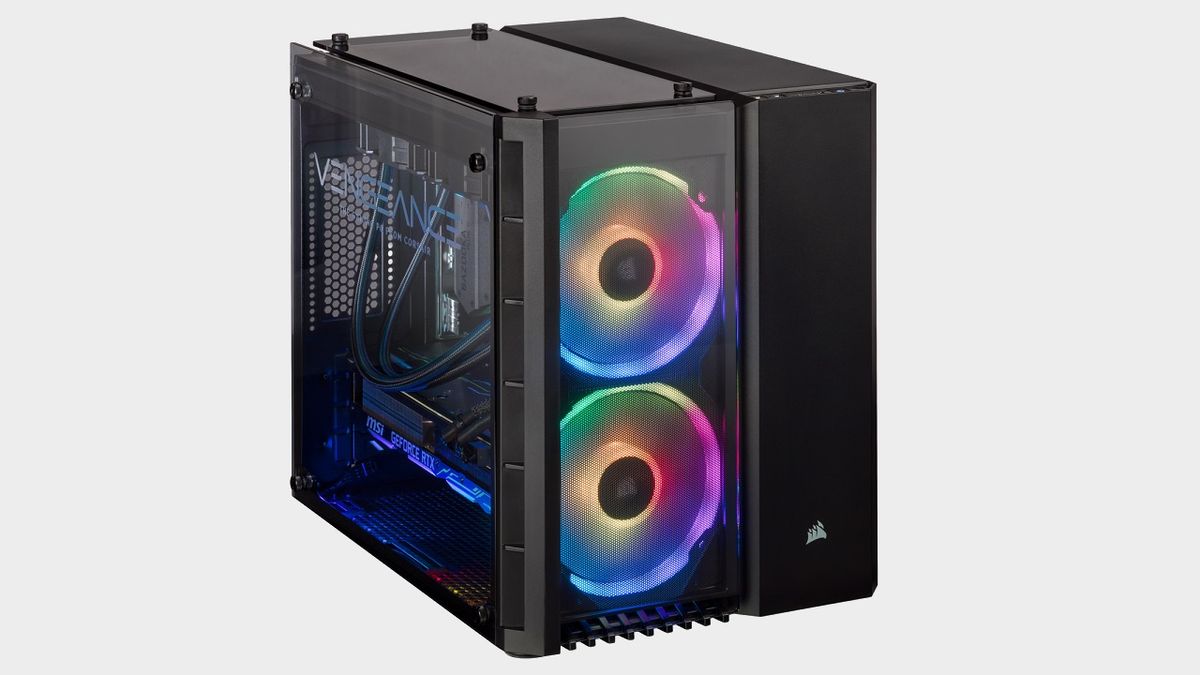12DOVE Verdict
An extremely well-built and brilliantly lit gaming PC that will keep you playing for years to come, and can be easily upgraded to keep pace with the next generation of games
Pros
- +
Excellent dual-chamber design
- +
Powerful components
- +
Brilliant RGB light display
Cons
- -
Very large
- -
CPU cannot be overclocked
Why you can trust 12DOVE
Corsair has long been a leading manufacturer of PC components and, given the range of parts and accessories they produce, it was almost inevitable that they'd eventually move into the prebuilt PC space. They found early success with their compact Corsair One, and that trend continues with the even more fully-featured and impressive Vengeance 5180, a beautiful behemoth packed with mighty components and lit in dazzling RGB to serve as the centerpiece of your entertainment empire.
The Vengeance is loaded with parts to keep it competitive well into the next generation of gaming (heralded by a growing slate of rumours surrounding Sony PS5 and Microsoft's Project Scarlett) , and a masterpiece of design and aesthetics, assuming you don't mind a massive cube anchoring your entertainment center. But it's not just some black obelisk; Corsair has designed the Vengeance to be as attractive as it is capable.
For a look at some other great choices, bop over to our best gaming PC roundup, and since it doesn't come bundled with a monitor, check out our list of the best gaming monitors as well.
Corsair Vengeance 5180 - Design
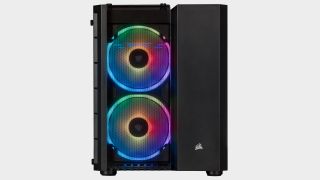
The first and most striking thing you'll notice about the Vengeance is its pulsating array of colored lighting, pouring out of the main chamber of the PC through tempered glass panels that line the side, front, and top. That beautiful tempered glass, which sports the machine's name in futuristic font, is lifted slightly from the body of the case by screws to allow for proper airflow and ventilation, and it looks and feels sleek and premium. It showcases the generous main chamber interior, where you'll find the brilliantly lit performance parts: the CPU, GPU, motherboard, and RAM, as well as the Corsair's elaborate cooling system. The case itself is a large cube, and Corsair puts the extra space to excellent use.
The Vengeance features a dual-chamber design; alongside the main chamber lies a secondary chamber where the drives, PSU, and cable management system are all tucked quietly and invisibly away. It's a brilliant way to not only highlight the build's unique aesthetic but, more practically, to ensure you're not wrestling with a massive cable snake every time you upgrade or add components in the main chamber. It's that rare combination in gaming-branded PC design that is both functional and visually appealing, and it's one of my favorite elements of the Vengeance package.
Corsair Vengeance 5180 - Performance
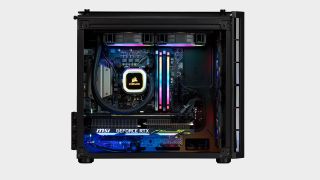
The Vengeance comes loaded with Nvidia's second mightiest 20-series GPU, the RTX 2080, fully ready to enable your raytracing, DLSS-powered gaming future. While those flagship elements have yet to appear in games in a meaningful way, the raw horsepower of the 2080 is appreciated, backed by a Core i7-8700 processor on a B360 board that's more than capable of keeping pace with Nvidia's potent GPU.
One of the few drawbacks in terms of components is that the CPU is a non-K model on a B board, so you won't be able to overclock it for additional performance if you do decide you need a little extra umph from your CPU, but it's still a solid 8th generation processor. Cinebranch benched it at 1378 cb (194 on a single core), so it is very unlikely to bottleneck your system. The rig's 480GB M.2 SSD clocked in at a very respectable 1392 MB/s read speed and 635.3 MB/s write, so it'll breeze through loading times on even the most demanding triple-A games, and while the Vengeance only packs 16GB of 2666 DDR4 by default, there are two empty DIMM slots if you decide to tuck in additional memory.
Testing the Vengeance against some recent triple-A titles, it showed very strong performance at 1080p and 1440p on ultra settings, but started to struggle significantly at 4K. In Shadow of the Tomb Raider's internal benchmark utility the Vengeance was able to output a consistent 58 FPS at 1440p but dropped to less than half that, 28 FPS, when set to 4K. Results from Total War: Warhammer 2 were significantly lower, reaching only 25.3 FPS at 1440p and a meager 9.8 FPS at 4K. Fiddling with some of the more demanding visual features, I was able to get a steady 30-40 frames from either game at 4K, but it did mean sacrificing some other elements of visual fidelity, particularly in Total War's case. It's also worth noting that neither game takes advantage of ray tracing or DLSS (Shadow of the Tomb Raider's long promised ray tracing support still hasn't been patched in). Given ray tracing's significant effect on performance it's likely that Vengeance owners will find themselves having to sacrifice either resolution or DXR, at least until developers can make more optimized use of Nvidia's fancy new lighting tech.
Corsair Vengeance 5180 - Features
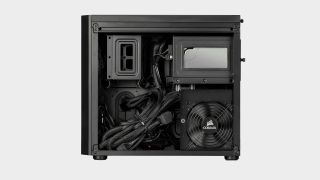
Corsair allows owners to tinker with the lighting and cooling features of the Vengeance via their proprietary iCue software suite, which isn't one of the most intuitive pieces of customization software but does feature an impressive depth of options. It is a little light on USB ports, with a pair of 3.1 slots in the front a four 2.0 ports tucked into the back of the machine. As someone who has some very extensive USB port needs between my keyboard, mouse, mic, Oculus Rift, printer - hell, even the vibrating GT Throne gaming chair I'm currently testing requires a USB connection - six ports feels inadequate, but it's possible I'm an edge case. On the other hand, the thoughtful cable-management system that keeps all those thickly braided PSU cables secured in the second chamber, and other nice touches like a capacious 2TB HDD for storage and the inclusion of Corsair's K55 keyboard (a decent starting rubber dome gaming keyboard) and Harpoon RGB gaming mouse round out what is a very compelling package.
Overall - should you buy it?
The Vengeance is an excellent machine that was clearly designed with gamers who want to just plug and play in mind. It's powerful and versatile enough to serve as your main rig for years to come, and pretty and flashy enough to wow friends and family who stop by to ogle your new investment. While power users may be disappointed by the lack of an overclockable CPU they'll be pleased with the operating space in the main chamber and the ease by which components can otherwise be altered or upgraded. Given that assembling the same build yourself would cost you nearly as much as the Vengeance at MSRP, Corair's new gaming machine is an excellent value for anyone who wants the security of a warranty and to avoid the labor (and potential tribulations) of building your own rig.
Alan Bradley was once a Hardware Writer for GamesRadar and PC Gamer, specialising in PC hardware. But, Alan is now a freelance journalist. He has bylines at Rolling Stone, Gamasutra, Variety, and more.

Solo Leveling's Jinwoo English dub actor says he wrote part of the anime show's most heartbreaking scene and it made him "start bawling"
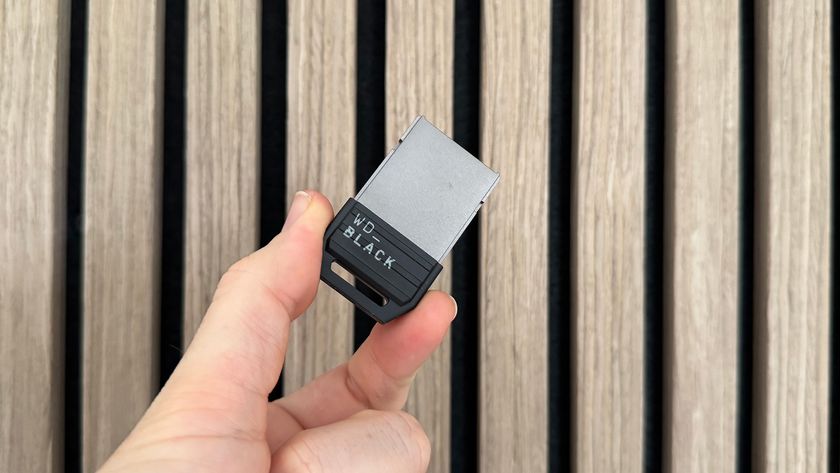
WD Black C50 2TB review: "Imperceptibly similar when compared to the Series X internal drive"

PlayStation needs to "reconsider" its push for "cutting-edge graphics" and "change our way of thinking" says former Sony boss
